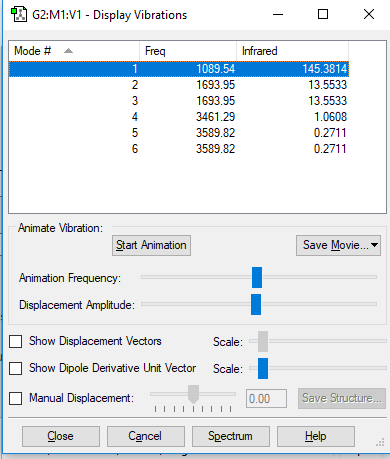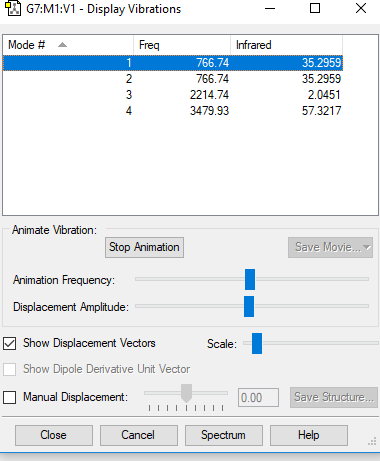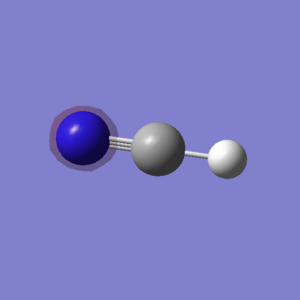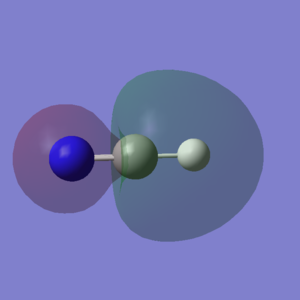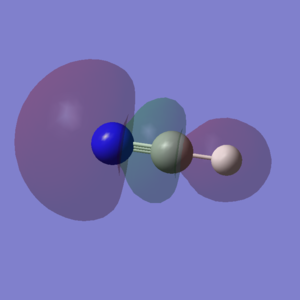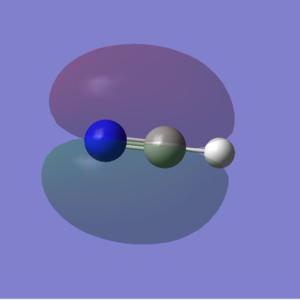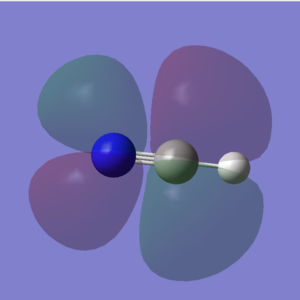Rep:Mod:YC15218
NH3
Optimisation
Summary Information
Molecule name: NH3
Calculation method: RB3LYP
Basis set: 6-31G(d,p)
Final energy E(RB3LYP) in atomic units (au): -56.55776873
The point group of molecule: C3V
Optimisation Information
Item Value Threshold Converged? Maximum Force 0.000004 0.000450 YES RMS Force 0.000004 0.000300 YES Maximum Displacement 0.000072 0.001800 YES RMS Displacement 0.000035 0.001200 YES Predicted change in Energy=-5.986277D-10 Optimization completed. -- Stationary point found. ---------------------------- ! Optimized Parameters ! ! (Angstroms and Degrees) ! -------------------------- -------------------------- ! Name Definition Value Derivative Info. ! -------------------------------------------------------------------------------- ! R1 R(1,2) 1.018 -DE/DX = 0.0 ! ! R2 R(1,3) 1.018 -DE/DX = 0.0 ! ! R3 R(1,4) 1.018 -DE/DX = 0.0 ! ! A1 A(2,1,3) 105.7412 -DE/DX = 0.0 ! ! A2 A(2,1,4) 105.7412 -DE/DX = 0.0 ! ! A3 A(3,1,4) 105.7412 -DE/DX = 0.0 ! ! D1 D(2,1,4,3) -111.8571 -DE/DX = 0.0 ! -------------------------------------------------------------------------------- GradGradGradGradGradGradGradGradGradGradGradGradGradGradGradGradGradGrad
NH3 |
Optimised N-H bond distance: 1.02Å
Optimised H-N-H bond angle: 106°
Link to Completed NH3 Optimisation: Optimized NH3
Vibrations and Charges
Display Vibrations Table
Table of Vibrations and Intensities
| wavenumber cm-1 | 1090 | 1694 | 1694 | 3460 | 3590 | 3590 |
| symmetry | A1 | E | E | A1 | E | E |
| intensity in arbitrary units | 145 | 14 | 14 | 1 | 0 | 0 |
| image | 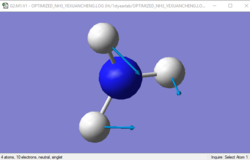
|
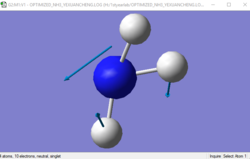
|
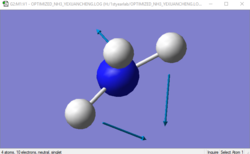
|
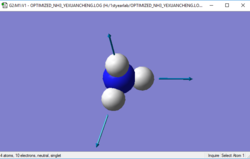
|
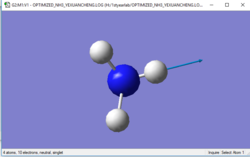
|
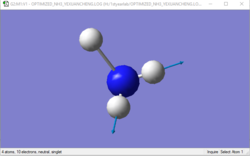
|
Q&A
Q:How many modes do you expect from the 3N-6 rule?
A:6 modes are expected(3*4-6).
Q:Which modes are degenerate (ie have the same energy)?
A:Modes with wavenumbers of 1694 are degenerate. Modes with wavenumbers of 3590 are degenerate.
Q:Which modes are "bending" vibrations and which are "bond stretch" vibrations?
A:Modes with wavenumbers of 1090 and 1694 are "bending" vibrations. Modes with wavenumbers of 3460 and 3590 are "bond stretch" vibrations.
Q:Which mode is highly symmetric?
A:The mode with wavenumber of 3640.
Q:One mode is known as the "umbrella" mode, which one is this?
A:The mode with wavenumber of 1090.
Q:How many bands would you expect to see in an experimental spectrum of gaseous ammonia?
A:4 bands are expected.
NBO Charges
Charge on N-atom: -1.125
Charge on H-atoms:0.375
Nitrogen is expected to have a negative charge and hydrogens are expected to have positive charges since nitrogen has greater electronegativity than hydrogen.
N2
Optimisation
Summary Information
Molecule name: N2
Calculation method: RB3LYP
Basis set: 6-31G(d,p)
Final energy E(RB3LYP) in atomic units (au): -109.52412868
The point group of molecule: D*H
Optimisation Information
Item Value Threshold Converged?
Maximum Force 0.000001 0.000450 YES
RMS Force 0.000001 0.000300 YES
Maximum Displacement 0.000000 0.001800 YES
RMS Displacement 0.000000 0.001200 YES
Predicted change in Energy=-3.401159D-13
Optimization completed.
-- Stationary point found.
----------------------------
! Optimized Parameters !
! (Angstroms and Degrees) !
-------------------------- --------------------------
! Name Definition Value Derivative Info. !
--------------------------------------------------------------------------------
! R1 R(1,2) 1.1055 -DE/DX = 0.0 !
--------------------------------------------------------------------------------
GradGradGradGradGradGradGradGradGradGradGradGradGradGradGradGradGradGrad
N2 |
Optimised N-N bond distance: 1.11Å
Link to Completed N2 Optimisation: Optimized N2
Vibrations and Charges
Display Vibrations Table
Table of Vibrations and Intensities
| wavenumber cm-1 | 2457 |
| symmetry | SGG |
| intensity in arbitrary units | 0 |
| image | 
|
NBO Charges
Both nitrogen atoms have charge of zero which is what I expect since N2 is a homoatomic molecule.
H2
Optimisation
Summary Information
Molecule name: H2
Calculation method: RB3LYP
Basis set: 6-31G(d,p)
Final energy E(RB3LYP) in atomic units (au): -1.17853936
The point group of molecule: D*H
Optimisation Information
Item Value Threshold Converged?
Maximum Force 0.000000 0.000450 YES
RMS Force 0.000000 0.000300 YES
Maximum Displacement 0.000000 0.001800 YES
RMS Displacement 0.000001 0.001200 YES
Predicted change in Energy=-1.164080D-13
Optimization completed.
-- Stationary point found.
----------------------------
! Optimized Parameters !
! (Angstroms and Degrees) !
-------------------------- --------------------------
! Name Definition Value Derivative Info. !
--------------------------------------------------------------------------------
! R1 R(1,2) 0.7428 -DE/DX = 0.0 !
--------------------------------------------------------------------------------
GradGradGradGradGradGradGradGradGradGradGradGradGradGradGradGradGradGrad
H2 |
Optimised H-H bond distance: 0.74Å
Link to Completed H2 Optimisation: Optimized H2
Vibrations and Charges
Display Vibrations Table
Table of Vibrations and Intensities
| wavenumber cm-1 | 4466 |
| symmetry | SGG |
| intensity in arbitrary units | 0 |
| image | 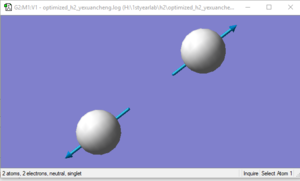
|
NBO Charges
Both hydrogen atoms have charge of zero which is what I expect since H2 is a homoatomic molecule.
Structure and Reactivity
Information of the Mono-metallic TM Complex that Coordinates with N2
Bis(dinitrogen)-dihydrido-bis(tricyclohexylphosphine)-ruthenium
Identifier: YECMIF
N-N distances:1.104(3)Å and 1.101(3)Å
These distances are smaller than the computational distance which is 1.11Å.
This may be explained by the interaction between nitrogens and the remaining part of the crystal such as hydrogen-bonding which would cause the bond distance to be smaller.
Also, when running the optimisation, the fully optimised structure is achieved which may differ from the one in reality.
Energy for the Haber-Bosch Process
E(NH3)= -56.55777 au
2*E(NH3)= -113.11554 au
E(N2)=-109.52413 au
E(H2)=-1.17854 au
3*E(H2)=-3.53562 au
ΔE=2*E(NH3)-[E(N2)+3*E(H2)]= -0.05579 au
ΔE=-146.5 kJ/mol
The ammonia product is more thermodynamically stable.
HCN
Optimisation
Summary Information
Molecule name: HCN
Calculation method: RB3LYP
Basis set: 6-31G(d,p)
Final energy E(RB3LYP) in atomic units (au): -93.42458132
The point group of molecule: C*V
Optimisation Information
Item Value Threshold Converged?
Maximum Force 0.000370 0.000450 YES
RMS Force 0.000255 0.000300 YES
Maximum Displacement 0.000676 0.001800 YES
RMS Displacement 0.000427 0.001200 YES
Predicted change in Energy=-2.062470D-07
Optimization completed.
-- Stationary point found.
----------------------------
! Optimized Parameters !
! (Angstroms and Degrees) !
-------------------------- --------------------------
! Name Definition Value Derivative Info. !
--------------------------------------------------------------------------------
! R1 R(1,2) 1.157 -DE/DX = 0.0004 !
! R2 R(2,3) 1.0686 -DE/DX = 0.0004 !
! A1 L(1,2,3,-2,-1) 180.0 -DE/DX = 0.0 !
! A2 L(1,2,3,-3,-2) 180.0 -DE/DX = 0.0 !
--------------------------------------------------------------------------------
GradGradGradGradGradGradGradGradGradGradGradGradGradGradGradGradGradGrad
HCN |
Optimized C-N bond distance: 1.16Å
Optimized C-H bond distance: 1.07Å
Optimized H-C-N bond angleː 180°
Link to Completed HCN Optimisation: Optimized HCN
Vibrations and Charges
Display Vibrations Table
Table of Vibrations and Intensities
| wavenumber cm-1 | 767 | 767 | 2215 | 3480 |
| symmetry | PI | PI | SG | SG |
| intensity in arbitrary units | 35 | 35 | 2 | 57 |
| image | 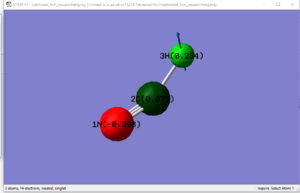
|
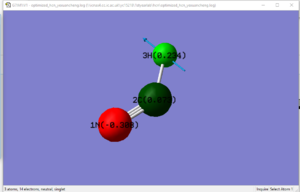
|
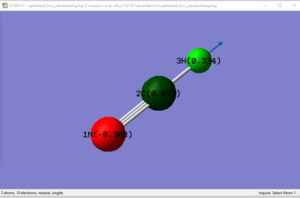
|
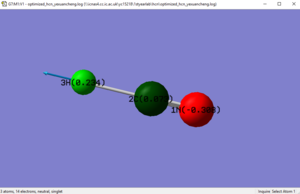
|
NBO Charges
Charge on N-atom: -0.308
Charge on C-atom: 0.073
Charge on H-atom: 0.234
Nitrogen is expected to have a negative charge and carbon and hydrogen are expected to have positive charges since nitrogen has greater electronegativity than the others.
Molecular Orbitals
Marking
Note: All grades and comments are provisional and subject to change until your grades are officially returned via blackboard. Please do not contact anyone about anything to do with the marking of this lab until you have received your grade from blackboard.
Wiki structure and presentation 1/1
Is your wiki page clear and easy to follow, with consistent formatting?
YES
Do you effectively use tables, figures and subheadings to communicate your work?
YES
NH3 0.5/1
Have you completed the calculation and given a link to the file?
YES
Have you included summary and item tables in your wiki?
YES
Have you included a 3d jmol file or an image of the finished structure?
YES
Have you included the bond lengths and angles asked for?
YES
Have you included the “display vibrations” table?
YES
Have you added a table to your wiki listing the wavenumber and intensity of each vibration?
YES
Did you do the optional extra of adding images of the vibrations?
YES
Have you included answers to the questions about vibrations and charges in the lab script?
YES, most answers are correct. However there are only 2 visible peaks in the spectra of NH3, due to the low intensity of the other 2 peaks. (See infrared column in vibrations table.)
N2 and H2 0.5/0.5
Have you completed the calculations and included all relevant information? (summary, item table, structural information, jmol image, vibrations and charges)
YES
Crystal structure comparison 0/0.5
Have you included a link to a structure from the CCDC that includes a coordinated N2 or H2 molecule?
No you gave the identifier but you did not include a link or valid reference to the CCDC.
Have you compared your optimised bond distance to the crystal structure bond distance?
YES
Haber-Bosch reaction energy calculation 1/1
Have you correctly calculated the energies asked for? ΔE=2*E(NH3)-[E(N2)+3*E(H2)]
YES
Have you reported your answers to the correct number of decimal places?
YES
Do your energies have the correct +/- sign?
YES
Have you answered the question, Identify which is more stable the gaseous reactants or the ammonia product?
YES
Your choice of small molecule 3/5
Have you completed the calculation and included all relevant information?
YES
Have you added information about MOs and charges on atoms?
YES, you included all the information and your explanations of the nitrogen charge and MO1 were particularly good. You could have improved by explaining why C and H have different charges. The MO explanations could have been improved by breaking down the specific interactions, for example the second MO shown increases the C-H bonding but decreases the N-C bonding. You also could have mentioned that the LUMO has no impact on the bonding in the molecule since it is unoccupied.
Independence 0/1
If you have finished everything else and have spare time in the lab you could:
Check one of your results against the literature, or
Do an extra calculation on another small molecule, or
Do some deeper analysis on your results so far
No independent work located.

